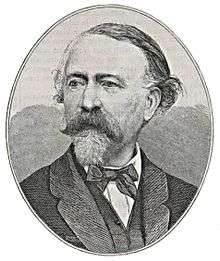Károly Thern
Károly (Carl) Thern (13 August 1817 – 13 April 1886)[1][2] was a Hungarian composer, pianist, conductor and arranger. He was of German descent, but was among the second generation of composers who developed the language of Hungarian art music.[3]

Thern was born in 1817,in Spišská Nová Ves (Zipser Neudorf in German, Iglo in Hungarian; now in Slovakia).[4]
He conducted at the National Theatre of Pest in 1840s, and at the Music Lovers' Association of Pest between 1868 and 1873, in succession to Mihály Mosonyi.[5] He was also active as a teacher at the National Conservatory.
Thern's incidental music included Svatopluk by József Gaál (1839) in which he introduced the tárogató alongside standard orchestral instruments.[6] His operas included Gizul (premiered 21 December 1841), The Siege of Tihany (Tihany ostroma; 12 April 1845), and The Would-be Invalid (A képzelt beteg; 11 October 1855).[7][8][9] Gizul was described as a "... remarkable reflection of the endeavour to give [its] schooling [i.e. musical technique] a Hungarian character, to adorn it as if it were in Hungarian garment".[10] His other music includes a Symphony (1871);[11] a Trio in D minor for two violins and viola, Op. 60;[12] a Hungarian March for piano 6-hands;[13] Landleben, 8 Character Pieces for piano, Op. 38;[14] a Nocturne for solo piano,[15] and songs for plays about Hungarian village life. Thern's music has been rediscovered by the Hungarian pianist Ilona Prunyi.[16]
Karoly Thern made a number of arrangements for piano duet or two pianos, including:
- Grieg's Piano Concerto in A minor (commenced by Grieg and added to by Thern; Thern's version was published in Leipzig in 1876 and has been recently recorded for the first time)[17][18][19]
- Beethoven's 4th Piano Concerto[20]
- Liszt's Hungarian Rhapsody No. 15 "Rakoczy March" (under the pseudonym "Reth. N. Karoly")[21]
- Schumann's Andante and Variations for 2 pianos, 2 cellos and horn, Op. 46[22]
- Karl Goldmark's Overture Sakuntala, Op. 13[23]
- Robert Volkmann's Variations on a Theme of Handel, Op. 26.[24]
His sons Willi and Louis Thern were his best piano students, and they became a famous team of duo pianists and later teachers.
Thern was an ardent champion of Franz Liszt, who used his melody Fóti dal in his Hungarian Rhapsody No. 1. Liszt dedicated Eucharistia to Karoly Thern, and his arrangement for piano 4-hands of the marches by Franz Schubert to his sons Willi and Louis.
External links
References
- World of Quotes Archived 8 December 2010 at the Wayback Machine. World of Quotes. Retrieved on 11 January 2012.
- "Chronology of Notable Deaths". Archived from the original on 1 May 2009. Retrieved 19 April 2009.
- Conceptualising National Music in Hungary and Romania. None. Retrieved on 11 January 2012.
- Oesterreichisches Musiklexikon on line. Musiklexikon.ac.at (14 December 2009). Retrieved on 11 January 2012.
- Mosonyi Mihály: Transcriptions And Marches For Piano. Kassai-istvan.hu. Retrieved on 11 January 2012.
- The Brief History of the Tarogato Archived 19 December 2008 at the Wayback Machine
- Italian Opera. Italian Opera. Retrieved on 11 January 2012.
- A Concise History of Hungarian Music. Mek.niif.hu. Retrieved on 11 January 2012.
- Operairodalom. None. Retrieved on 11 January 2012.
- Ferenc Erkel Operas. Zti.hu (13 November 1933). Retrieved on 11 January 2012.
- Symphonies-Dates
- Viola Sheet Music Archived 29 December 2009 at the Wayback Machine. (PDF) . Retrieved on 11 January 2012.
- TrioDan. TrioDan. Retrieved on 11 January 2012.
- Hofmeister XIX Archived 3 April 2009 at the Wayback Machine
- "Kodály Jubileum 125". Archived from the original on 29 December 2008. Retrieved 19 April 2009.
- March 2006&l=en Budapest Spring Festival. Btf.hu. Retrieved on 11 January 2012.
- divine art Archived 4 July 2008 at the Wayback Machine. divine art. Retrieved on 11 January 2012.
- Music Web International. Music Web International. Retrieved on 11 January 2012.
- Divine Art Archived 27 October 2009 at the Wayback Machine. Divine Art. Retrieved on 11 January 2012.
- Antikvariat Enhorningen Archived 17 August 2010 at the Wayback Machine. Svaf.se (26 September 2011). Retrieved on 11 January 2012.
- Franz Liszt’s music manuscripts in the national Széchényi Library, Budapest. Books.google.com.au. Retrieved on 11 January 2012.
- Music for two pianos 8-hands. Nikhef.nl. Retrieved on 11 January 2012.
- "Musikantiquariat Katzbichler" (PDF). Archived from the original on 21 September 2003. Retrieved 27 September 2013.CS1 maint: BOT: original-url status unknown (link)